All-22: Cliff Avril and Michael Bennett break down the Seahawks’ pass rush

RENTON, Wash. — Walking into the Seahawks’ defensive line meeting room, you’re struck by various poster-sized odes to getting off the ball quickly and kicking all kinds of ass once you do, along with numerous technical and schematic details I’m not allowed to tell you about here (or anywhere else). It’s here that Michael Bennett and Cliff Avril, the best 4–3 pass-rushing duo in the NFL, hone their individual talents in a defense that plays perfectly to their skill sets. And it’s here that I sat down with them to break down their game tape over the last three seasons.
Both players signed with the Seahawks before the 2013 season, and they’ve become the point men on the front line of a defense that has, at times, been historically great. This season, Bennett is tied with Miami’s Olivier Vernon for the NFL lead among 4–3 defensive ends with 75 total pressures; Avril ranks third with 66. Avril is the outside speed rusher; selected in the third round of the 2008 draft out of Purdue by the Lions, he’s amassed 60 sacks in his eight-year career, and there have been times, especially this season, when he’s been just about unblockable.
Bennett is a different cat, on and off the field. An undrafted free agent and unconventional thinker out of Texas A&M who broke into the league in 2009, he had a cup of coffee with Seattle in 2009 but had to sign with the Bucs to get his start—the Seahawks’ previous front office didn’t see his potential.
O-line issues flare up as Seahawks take stock of playoff chances
But the new Seattle brass did after the 2012 season, in which Bennett put up 71 total pressures for Tampa Bay. He has rewarded the Seahawks’ faith in every possible way. At 6'3" and 270 pounds, Bennett has a rare ability to play every gap along the line in a consistently disruptive fashion. I remember talking with Patriots offensive line coach Dave DeGuglielmo in the week before Super Bowl XLIX about how to stop Bennett in particular. The normally outspoken and gregarious coach got quiet. He paused, sighed, and compared Bennett to Reggie White(!) in his ability to mess things up from just about any spot on the line. That versatility was proven on New England’s first four offensive plays of the game, when Bennett moved from wide-nine left end, to left tackle, to right tackle, to right end, and made an impact on every single play.
Before I spoke with Bennett and Avril in their prep room in mid-December, I was well aware that they were great individual players. What I got out of that half-hour of watching tape with them was an entirely new understanding of how important it is for great pass rushers to work together. Over and over, Bennett and Avril would refer to how one player stayed outside, and the other moved down and in, and how one man helped the other to make a play. It was yet another illustration that football is the most interdependent sport, and if you don’t embrace that on the field, you don’t have much of a chance. Bennett and Avril embrace it every play, every game, and that’s the extra juice that’s made them among the best pass-rushing duos, regardless of scheme, over the last three seasons.
And with that, onto the tape. The clips broken down below are a combination of plays I wanted to review and plays they requested, with a whole lot of pass-rushing philosophy talk mixed in.
• KING: Upsets highlight Week 16 | KLEMKO: Home finales in SD, OAK, STL
Week 2 of the 2013 season vs. 49ers, 8:17 left in the second quarter
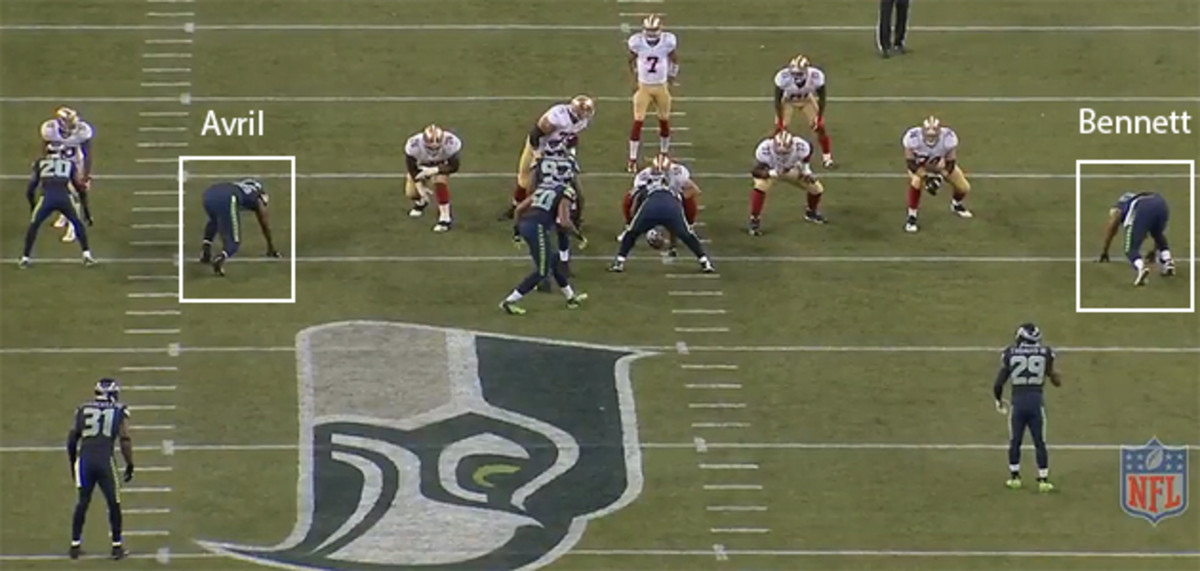
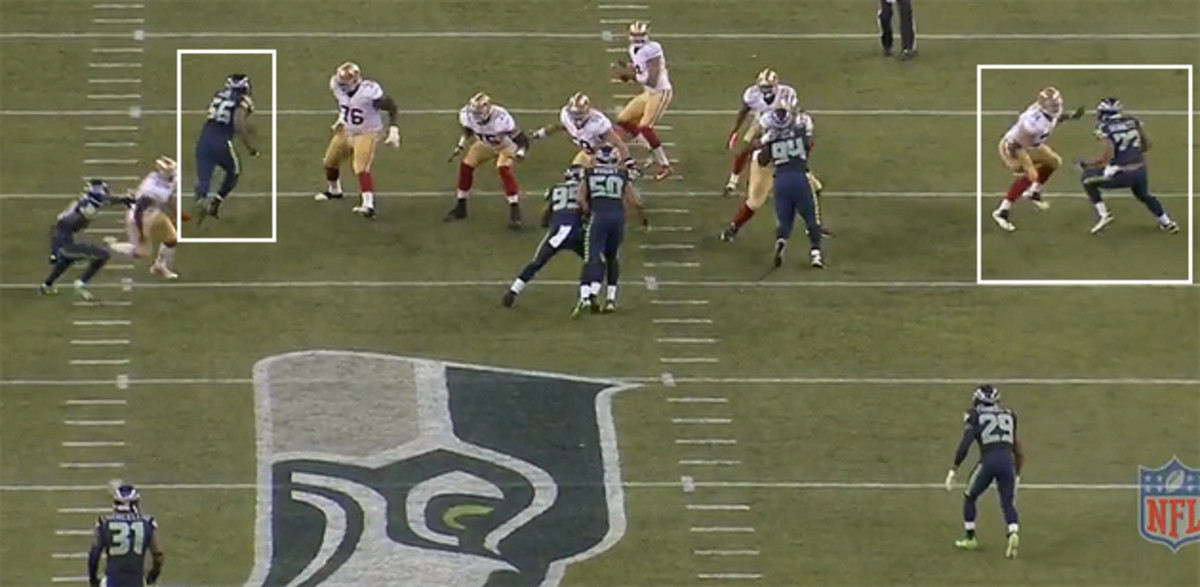
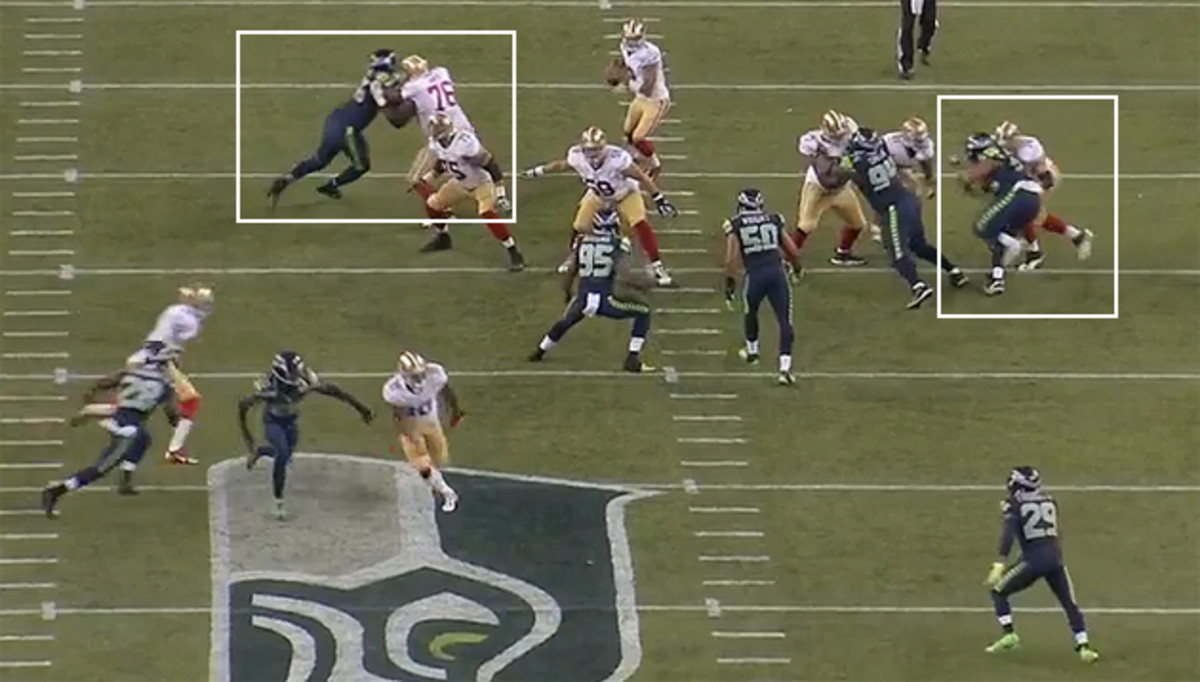
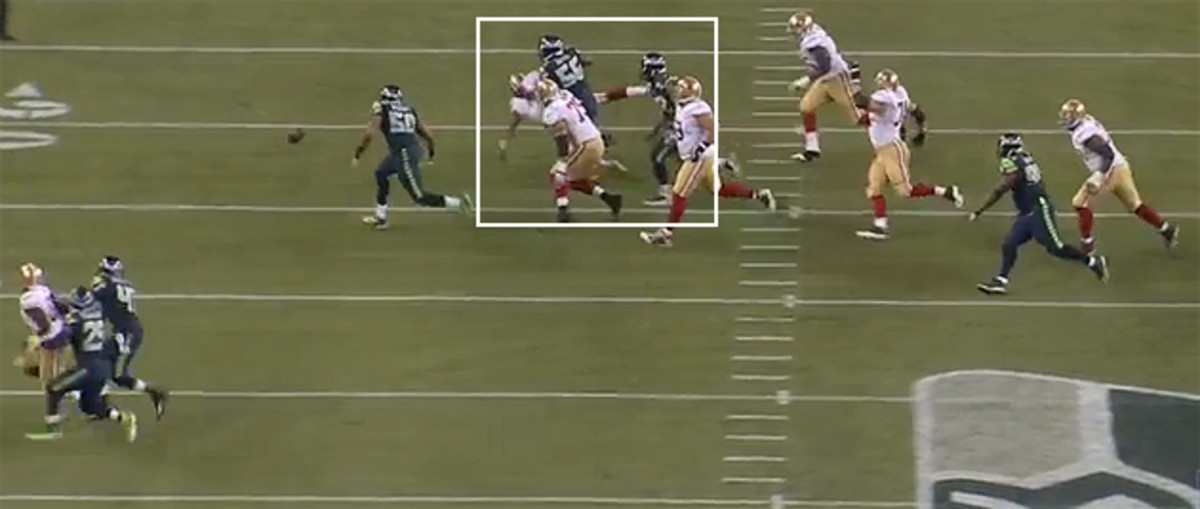
One of your first dual impact plays with the Seahawks. Colin Kaepernick goes down, fumbles, K.J. Wright recovers, and you guys both start this in wide edge sets. How did this happen?
Cliff Avril: We worked well on this one.
Michael Bennett: I worked up and under, and you came around.
Avril: No, I came up and back out on this one. Yeah, I spun back out. Right here, we knew it was pass, and we got a good jump. This week, we were talking about how we shouldn’t get too high on the rushes.
SI: Not getting your body too high?
Avril: No, like, not too far past the blockers in the rush. Here, once I got past a certain level, I had to spin back out, because I knew that B-gap was open. We were only rushing three guys, so I knew the B-gap would be open. [Kaepernick] was still looking downfield, so I hit his arm and got the ball out.
The man behind the legend: McGee’s story goes well beyond SB hangover
SI: This is the second regular-season game you guys played together—you were both signed by the Seahawks in 2013. At what point did you start to realize what you could do together?
Bennett: I think it was about this time, where we started to figure it out. We had a lot of rushers, so we wanted to figure out how to get everybody on the field and get in a good ... to have everybody rushing really well together. It took some time. For us, it was kind of early, and we were figuring out what each person could do well and work off that. On this play, where I went up and under and Cliff came around, he felt the pressure. Usually on this play, Cliff would keep going up, but he ended up going the opposite way and got a sack right here.
Avril: Personally, it was a natural thing. We just started paying attention to what type of rushers we were. Me naturally, I'm a speed-off-the-edge guy, and Mike is more of an inside speed-power guy. So, when I speed-rush, I can see him in my peripheral, and I can usually come underneath or whatnot. And we complement each other pretty well.
SI:And this type of play is a common construct, where you’re crossing the face and doing an inside counter. That’s a base pass rush concept?
Avril: It’s more of a third-down thing. Definitely a passing concept thing. I think, if [the quarterback] sees me while Mike is coming underneath, he’ll step into Mike. But if he sees Mike, he’ll run out that way, and I can chase him down.
SI: Depending on who you’re facing, do you adjust your techniques for a guard? Would you do it a different way based on the guys blocking you?
Bennett: Based on the quarterback, too. Is he a spinner outside the pocket, like Romo?
SI: So, with a guy like Kaepernick, where your cornerbacks might turn their backs in man coverage and he can exploit that as a runner, how do you adjust?
Avril: I think as a pass rusher, you make them deal with you. You're going to get the same look from me, and I'm going to see how you react to it. It's more so depending on the quarterback. If he's a mobile quarterback, you have to rush through your guy -- you have to keep your eye on the quarterback. But I think you just make them deal with you.
NFL playoff picture, Week 16: Latest standings, seeds and scenarios
SI:You both had success in your previous stops—Cliff, you in Detroit, and Michael, you in Tampa Bay. Were there different things to learn when you came to Seattle? How are you different players now?
Bennett: I think we came here and learned more about football—my knowledge of the game was already Super-Jedi [laughs], but working with [former Seattle defensive coordinator and current Falcons head coach Dan Quinn], he knows so much about football, it just takes your game up to another level. You’re able to understand what the offense is trying to do and how they’re trying to attack you—not being like a blind dog in a meat house, just running around trying to get everything. This is more about trying to figure out what you can do better.
Avril: I would definitely agree. Coming here, I was in my sixth season—you have a feel for the game, but once we got here ... being around more veterans as well, and we’re not afraid to learn from each other. We break down a lot of film here, and as you get older, that’s a majority of the game is breaking down film. It becomes mental. Here, they do a great job of helping you make that transition.
SI:Well, let's break down another one.
Week 13, 2013 vs. New Orleans, 6:37 left in the first quarter
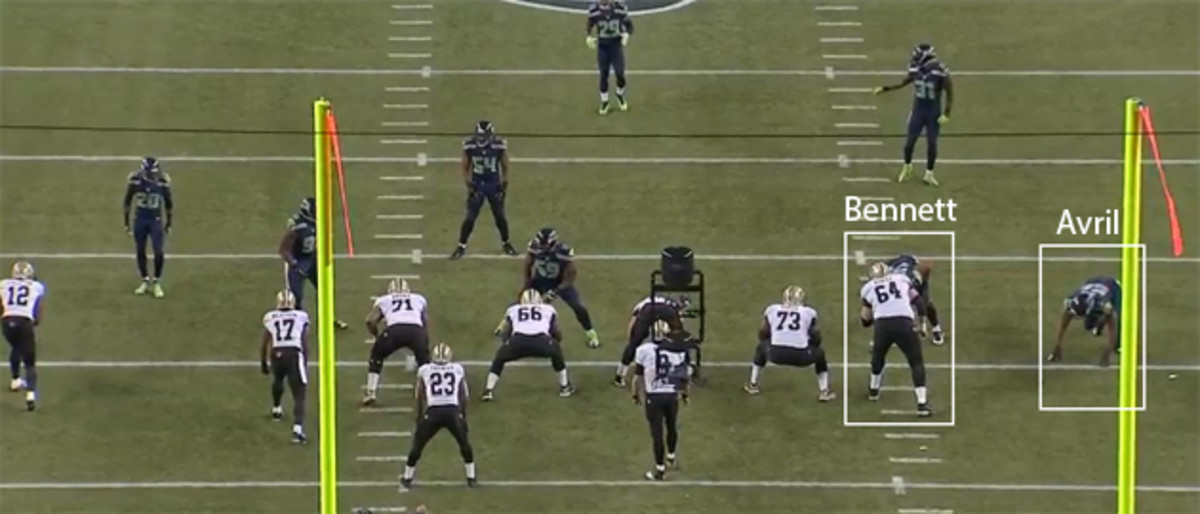
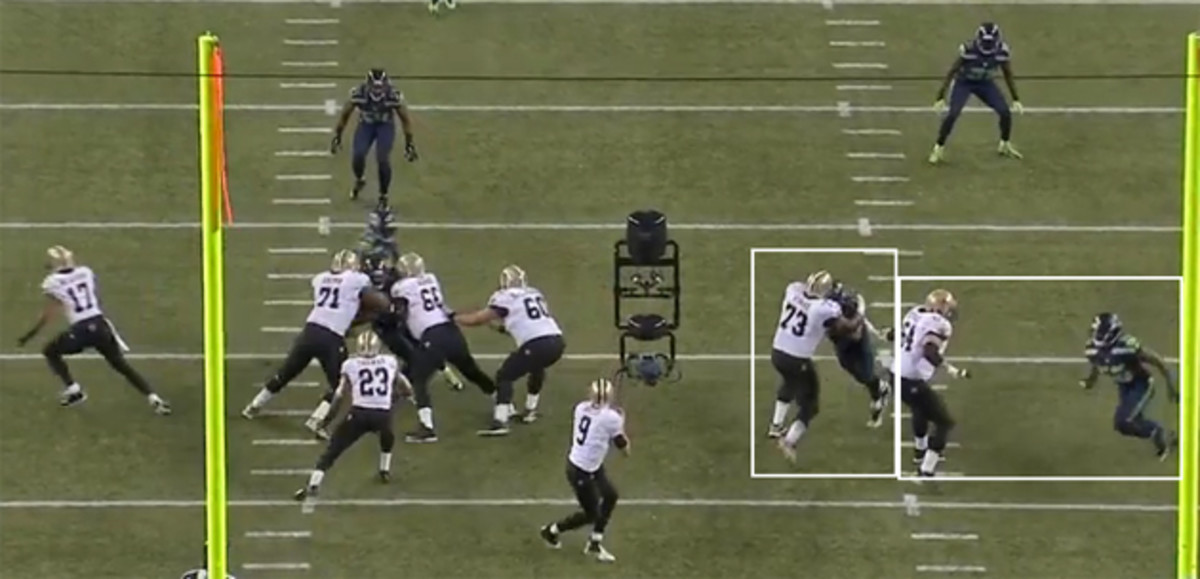
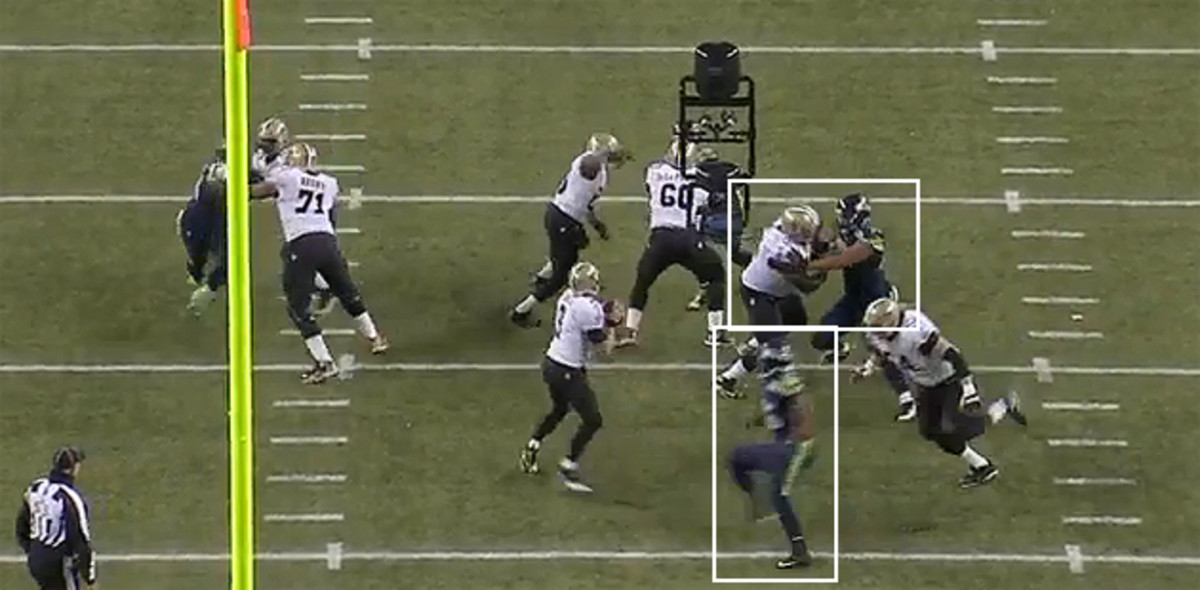
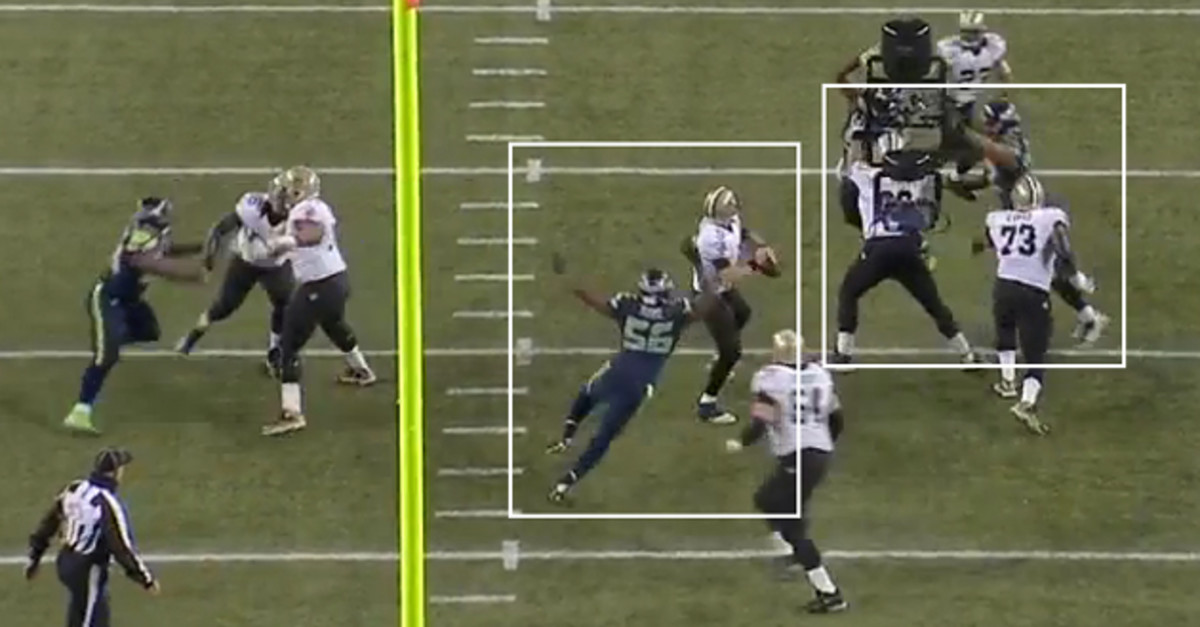
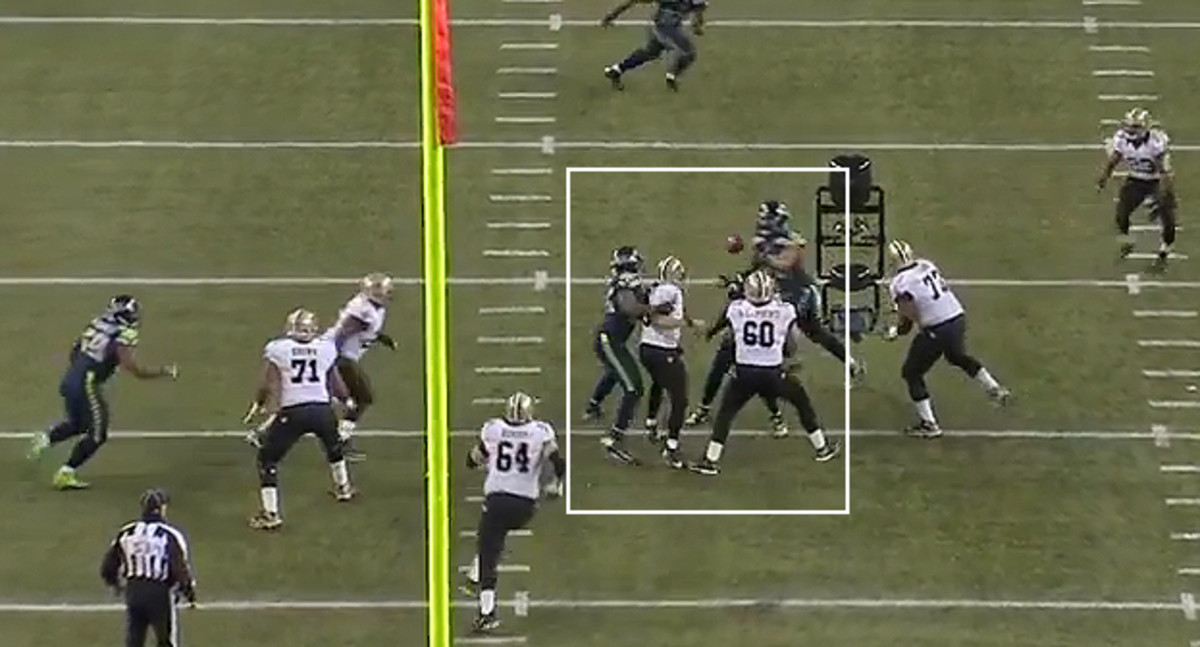
SI: Avril strip-sack, Bennett recovers for a touchdown. Walk me through this play, and tell me what happened.
Bennett: We were getting off the ball, and we had a good game [stunt]—I saw Cliff go up, and I was going to go up and under to make the quarterback step up. And then Clem [Chris Clemons] was going to come up and get him, but it just ended up working well for us. We ended up pushing the pocket, and I saw Cliff going upfield for the sack, and said, ‘He’s about to get a sack here!’ So, I just tried to catch the ball when I saw it coming out of [Drew Brees’s] hand.
Avril: Yeah, [Bennett] was pushing the guy back. I think Clem and Clinton McDonald, they were running a game on the backside, and I had a speed rush off the left side. [Brees] had nowhere to step up, because I ran kind of wide, and he didn’t have time, and Mike actually did one heck of a job catching the ball when it came out.
Bennett: I did return that thing—I was a high-school running back.
DF: I’ve asked Pete Carroll about this front—what I call the quotation-mark defense, where it’s you two guys on one side and two linebackers on the other, and he said that it basically forces the guard on your side to act like a tackle, and the guard would prefer not to. What does that mean? How does it change a protection when you guys do this?
Bennett: Usually, a guard is responsible for the depth of the pocket, and the tackle is responsible for the width of the pocket. So, when you take a guard and make him have to deal with the width of the pocket, too, it takes away from what he usually wants to do. He wants to keep the depth and keep you on a line, so the quarterback has time to step up and throw the ball. When you make him open up like a tackle, he’s not used to that. It’s too much space for him—it makes him regular. You take an in-the-box guy and make him outside the box, and he can’t handle it.
Avril: Yeah, they don’t like space. They don’t like having too much space, and the way Mike lines up, he forces the guard to become a tackle, because he’s so wide. Guards hate having too much time and having space.
SI: And that guard is Jahri Evans, a pretty great blocker.
Avril: Yeah, he’s pretty good. But if you make anybody uncomfortable ... they’re not used to having speedy guys that wide. And Mike takes full advantage of it.
On The Numbers: Another record for Marshall, a loss for Woodson, more
SI: Had either of you done anything like this before, with two ends rushing off the same side in a 4–3 base?
Avril: We used to do it a little bit in Detroit with Ndamukong Suh—he would line up that wide [as a five-tech like Bennett], and we had some success with that. But two defensive ends? No.
Bennett. No. But it’s an evolution, too. If you think about it, in that first year, it was a surprise. Nobody was doing that in the NFL but us, and now, more people are trying to do it, as far as rushing the passer—I’m starting to see other teams do it.
Avril: Most definitely.
Week 1, 2015 vs. Rams, 9:53 left in the game
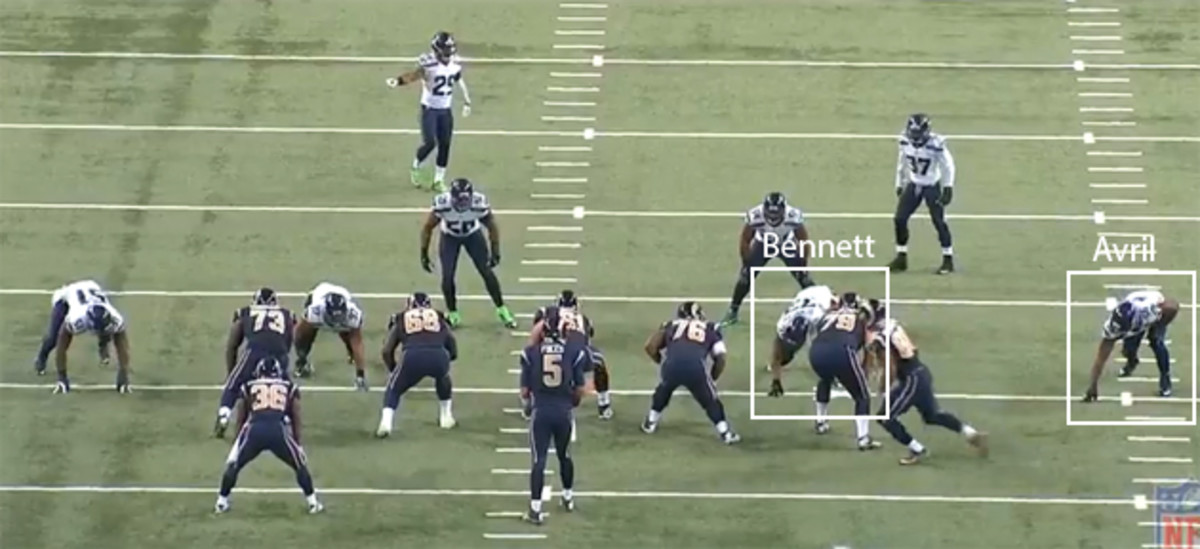
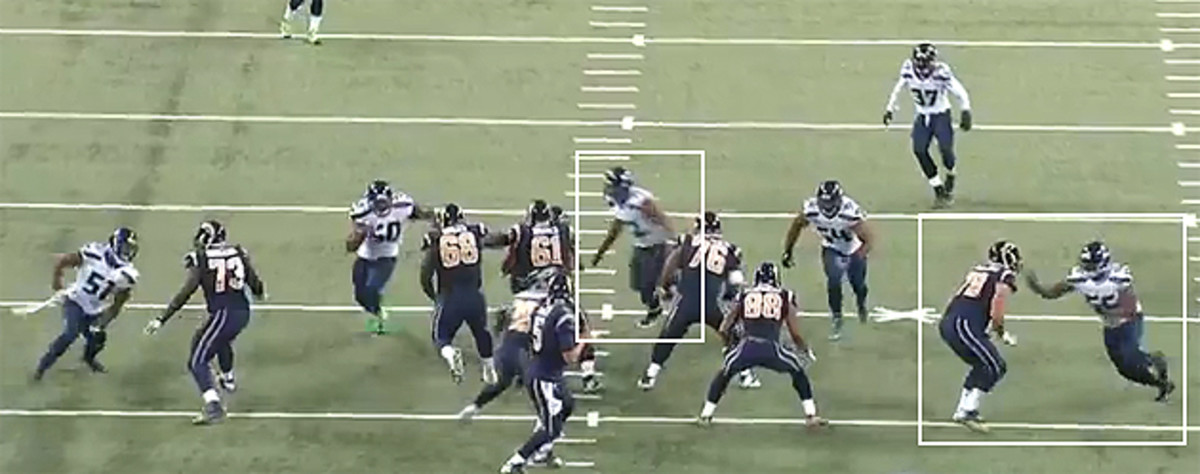
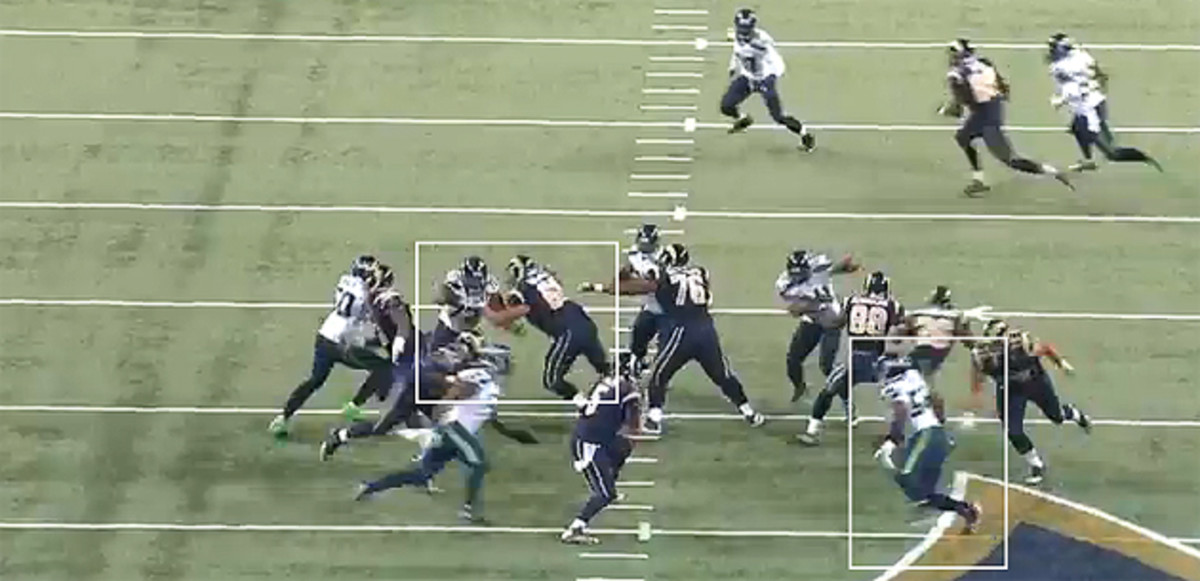
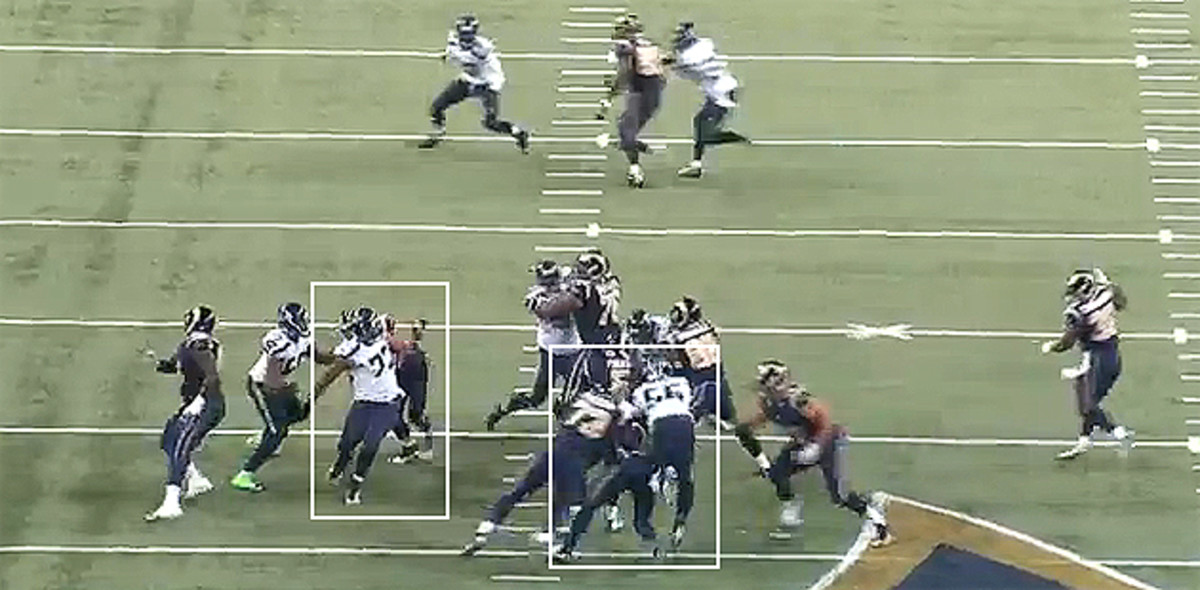
SI:There’s a lot of interesting stuff going on here on this near-sack that turned into a improbable completed pass from Nick Foles to Bennie Cunningham. Mike, you go all the way around on a stunt, and is this a dual-linebacker blitz? Bobby Wagner and K.J. Wright blitzing, and you move behind them?
Avril: Yeah. I move behind them, which gives Cliff a one-on-one by play design. Bruce Irvin did a good job here, too. But the object of the game is to try and get one of us in a one-on-one in some form or fashion. Because how we rush—so many teams just want to slide the protection and keep us from getting there. When they block the great ones, they don’t make any plays. Like J.J. Watt—someone finally schemed to him, and when you get double-teamed and triple-teamed, it’s hard to get a sack.
SI: It’s almost like a flood concept with receivers, where it’s an overload, but it’s a motion overload. You’re going across four linemen and coming all the way in.
Bennett: Yep. Looking for an open gap.
Avril: Like he said, the objective is to get your guys some one-on-ones by switching up the looks. They are doing a lot of different things this year, where they’re chipping, and maxing up. A lot of guys are getting double-teamed, so these are different things the coaches are coming up with. Sometimes, we’ll come up with different things to single up some guys, and you’ve just got to take advantage of it.
Week 11, 2015 vs. 49ers, 13:40 left in the first quarter
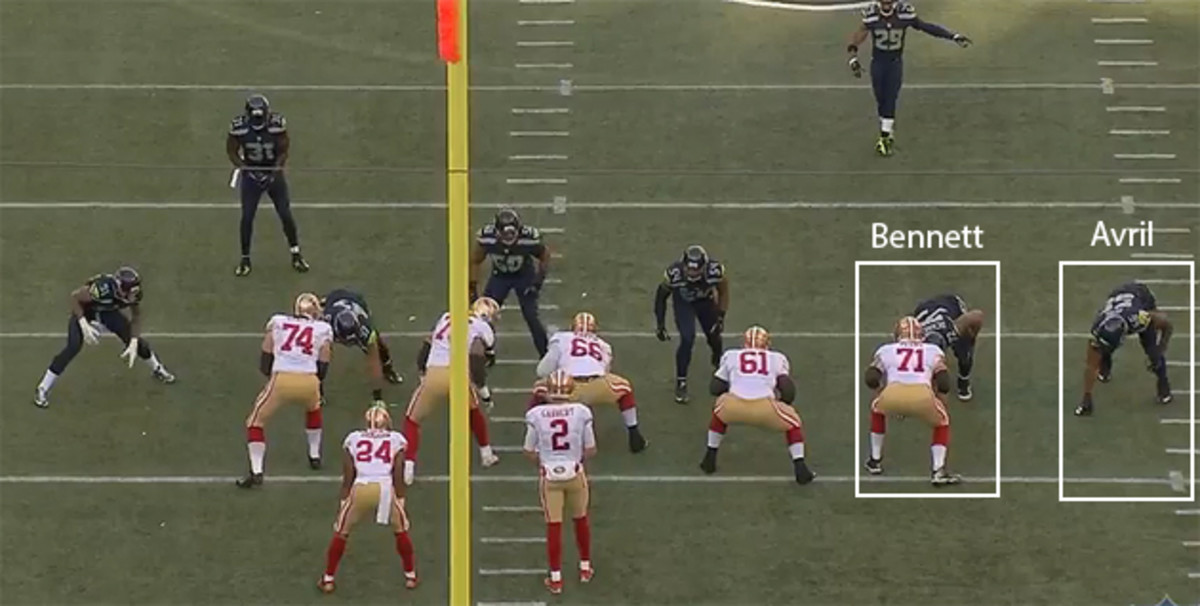
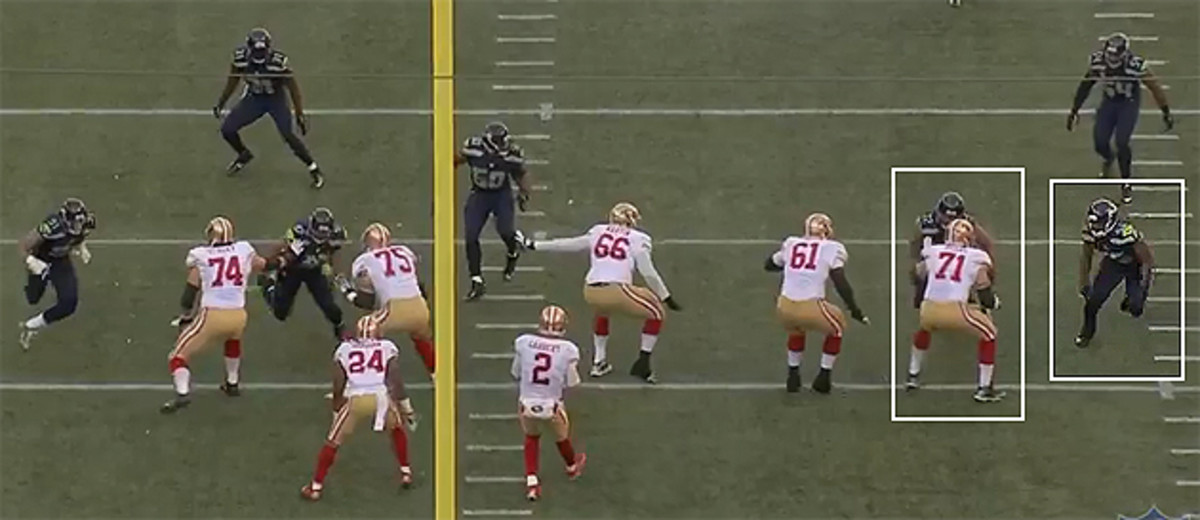
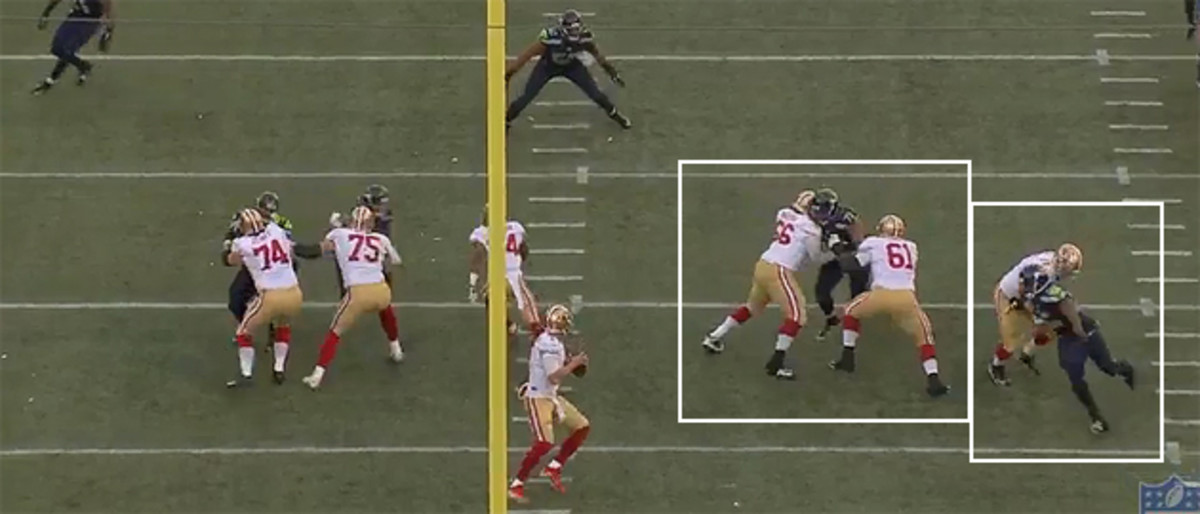
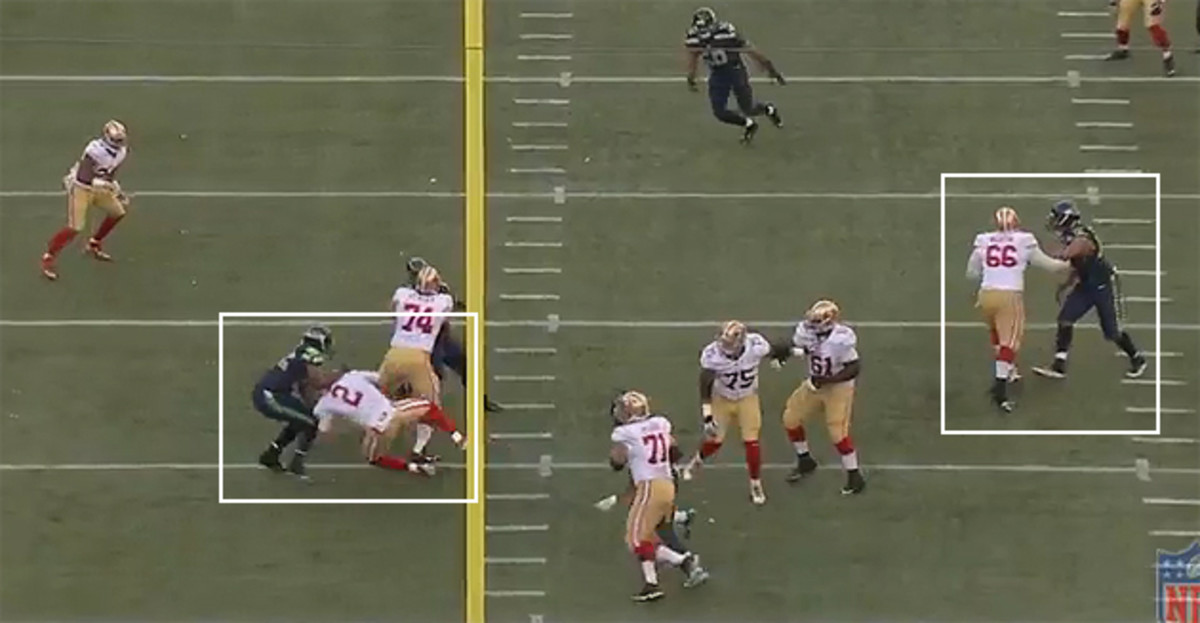
SI: Cliff, here’s an example of that dual-end look where you’re the beneficiary with a sack of Blaine Gabbert. What’s going on here? It’s another dual-end look, and a double-team of Mike, which gives Cliff the one-on-one.
Avril: Basically, this is credit to Mike B. Again, lining up wide, the tackle has to respect him as well. Sometimes, they’re a little slow getting out of their stance, because they might think we’re running a game or something like that. I try to take advantage of it by getting a great jump off the ball, and the edge is a little shorter, because Mike B. is so wide.
SI: Do you have ways of faking stunts and gap jumps? Making the line think you’re running a game and getting them out of position when you’re actually not?
Bennett: We’ve actually been talking about that lately.
Avril: You try to make the stance in your first couple steps the same. Even this past week [against Baltimore], me and him ran a really good game where it looks like a normal rush until the last second. I grabbed [the blocker], and Mike came around free to get a really good hit on the quarterback. You try and make things look the same off your first two steps and your alignment, and switch things up to keep them honest.
Bennett: Nobody has a better get-off than Cliff, especially at home, so with that one millisecond where you [the blocker] put your hand in that gap, it’s over. You’ve got to kick out wide.
Week 3, 2015 vs. Bears, 5:42 left in the fourth quarter
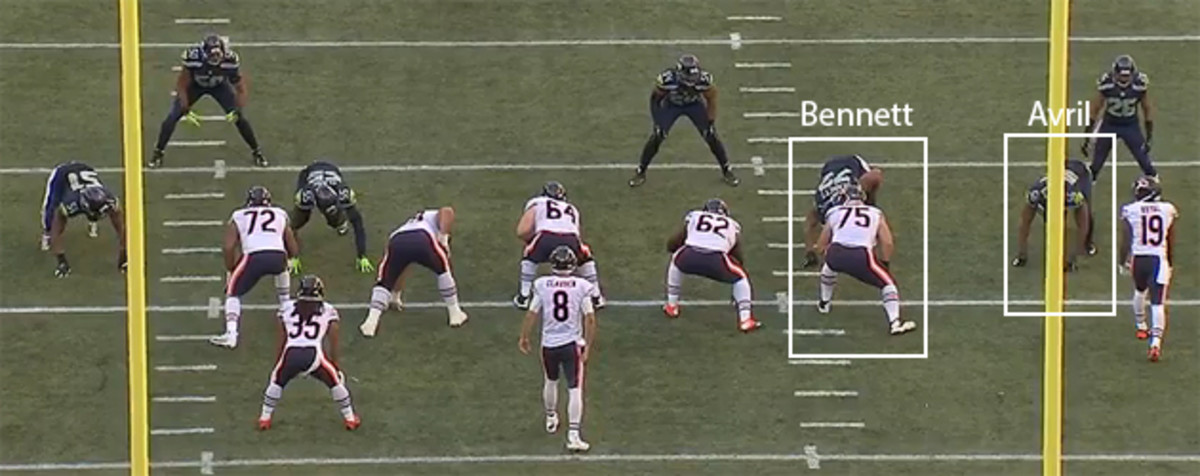
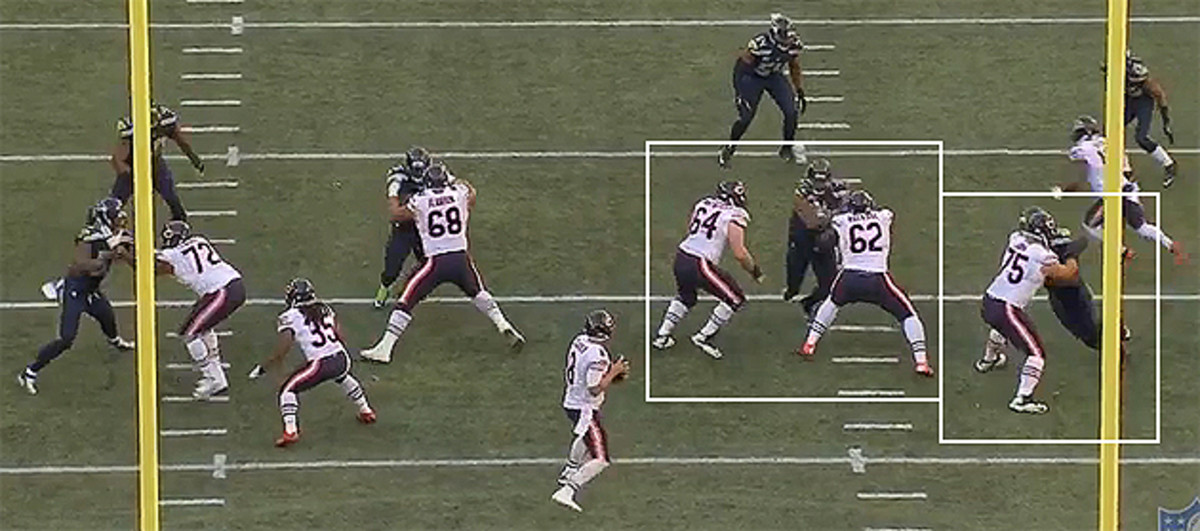
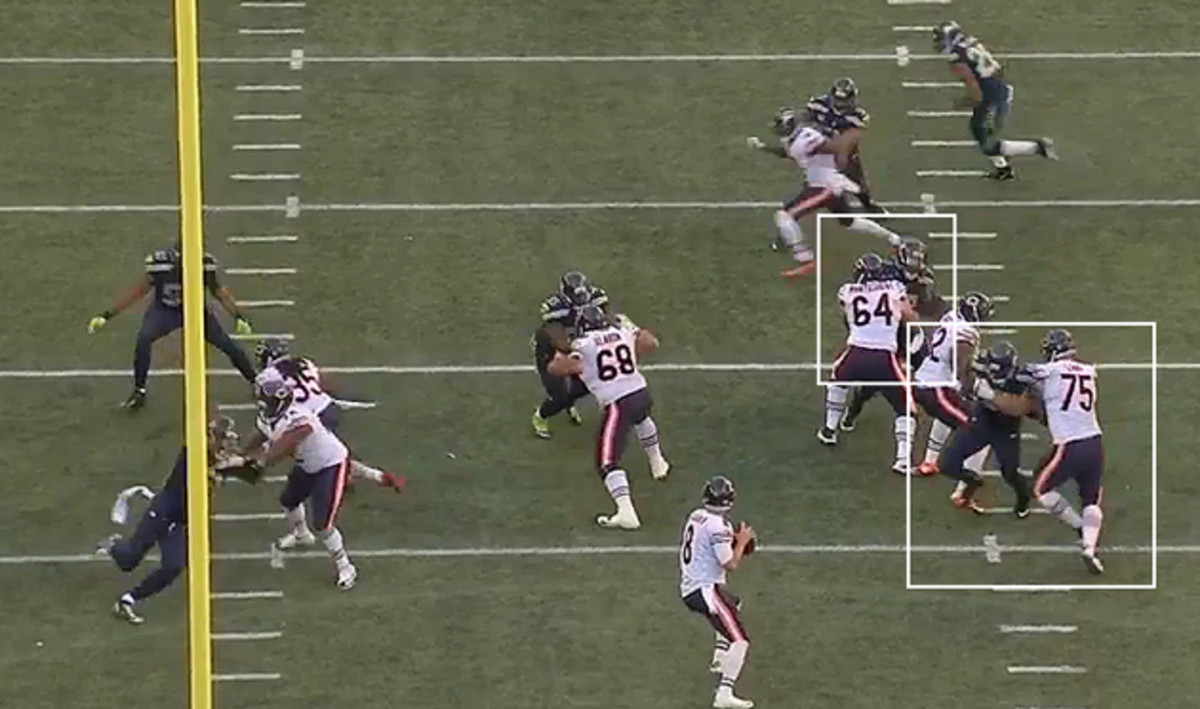
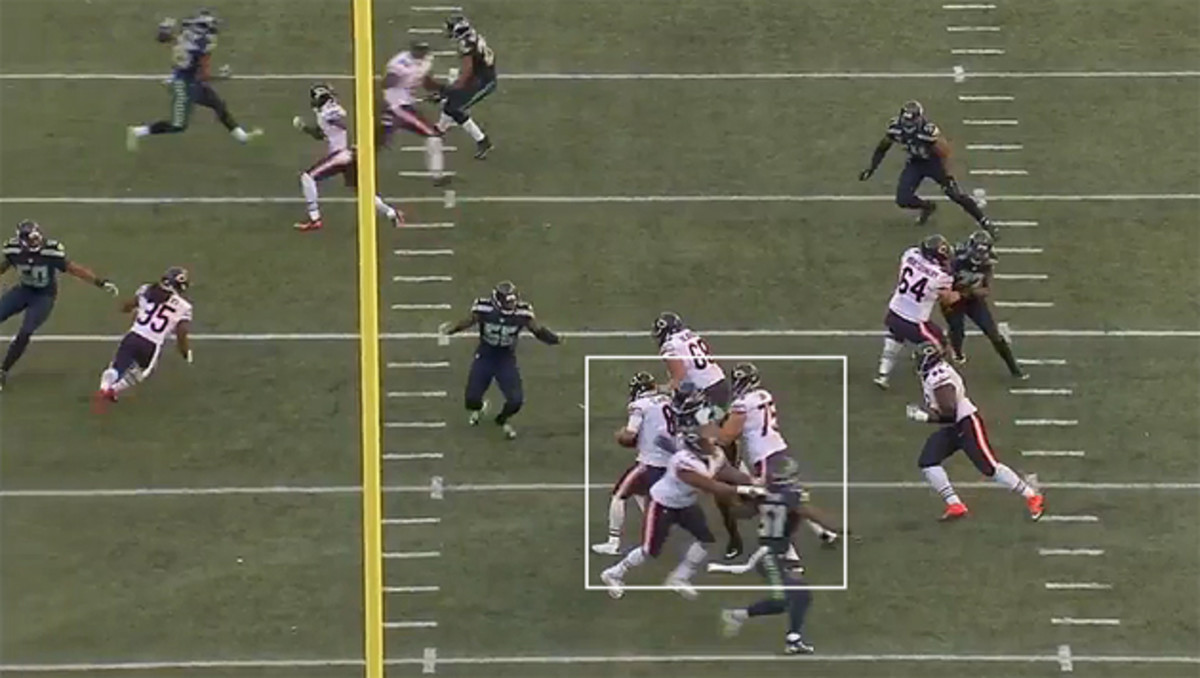
SI: Cliff, this sack of Jimmy Clausen is a great example of how you use technique and leverage to move an offensive lineman (Bears right tackle Kyle Long, in this case) where you want him to go. You’re bull-rushing, but you’re also taking Long at an angle. It’s a really good example of both power and technique.
Avril: They do go hand-in-hand. A lot of moves we use that end up working are because they worked prior to that snap. So, you’d set him up with speed to the edge, speed to the edge, and then you power him and finish outside. Then, you power him and finish inside. And I was able to get him, probably from some moves I’d done earlier in the game. I was able to power him, and he thought I was going outside, but I ended up finishing inside. And [Long] was still holding, by the way. Which they always do. Oh, and he also fumbled [laughs].
SI:How do you maintain enough leverage to get Long where you want him to go while you’re still moving side-to-side? How do you develop leverage from different angles? Because when we think of leverage, it’s more straight-on, and low man wins.
Avril: Well, the objective is to always be moving to the quarterback, in some kind of way. So, even in a pass rush like that, with an angle, I try to run on a straight line. If he crosses that line, I come underneath. If he doesn’t cross that line, I stay high. On this play, he was kind of head-up on me, so I felt it was only right to go underneath. You have to pick his arms to get him off-balance, and the quarterback was sitting right there.
Year in review: 10 controversies that defined the NFL and wishes for 2016
SI:I want to talk about Mike’s versatility a bit. Mike, I don’t think there’s any one series in your career that better epitomizes your gap versatility as a defensive lineman than the first four offensive plays the Patriots ran in Super Bowl XLIX. In those four plays, you moved from wide-nine left end, to left tackle, to right tackle, to right end, and I think you had two hurries on that drive. You’ve always seemed to have a knack to play at a really high level anywhere in the front. When did that start?
Bennett: My college coach [Dennis Franchione at Texas A&M], he wanted everyone to play inside first and learn that before you could be a good outside rusher. You had to be physical inside. So, if you were a freshman, you had to move inside and rush. When I got to the NFL, Dan Quinn, he pretty much wanted me to play inside.
SI:But you did that in Tampa Bay, too.
Bennett. Yeah, yeah. But when I came to Seattle, that's when I really started playing inside.
SI:You’ll see a lot of speed ends kind of dissolve when they try to play inside, and a lot of the inside guys just don’t have the burst to hit the outside shoulder off the edge. How are you able to make both things work?
Bennett: I think it’s just that I have the right body type. I just have the right body type to be able to do both of them, because I’ve played everywhere on the line, and everything you do, your feet have to be a certain type of way. That’s the thing you try and teach young guys: Your feet have to be ready to adjust to what your body’s doing. I’ve learned from some of the best inside rushers ever to play the game—from Warren Sapp to Albert Haynesworth. There are guys I talk to quite often, especially Warren Sapp, and I learn a lot from him about rushing.
SI:Sacks are the featured stat at your position, but how important are hits and hurries—total pressures—as part of your game?
Bennett: It’s really important, and that’s something we try and tell the young rushers. A sack is just one play. You get a sack on one play. But if you keep hitting a quarterback, that’s a toll on him the whole game. [Against the Ravens on Dec. 13], we each had five hits on the quarterback during the game. Like, ferocious hits. And those take a toll on the quarterback. Overall, if you look at J.J. Watt, he does have a lot of sacks. But he also has a lot of hurries and hits. So, it makes him one of the great pass rushers because he does it all. It’s not just a couple sacks here and a couple there. He has an impact on the game the whole time.
Week 3, 2015 vs. Bears, 15:00 left in the first quarter
SI: So, pass rushers make all the money, but I want to get into a little bit of run-stopping, too. You guys run a lot of four-man fronts, and you don’t blitz a lot. Your linebackers have their keys and reads and gaps, but it really does behoove both of you to focus on the run. You always have to have that awareness, as well.
Bennett: The run-stopping is important to this defense—we pride ourselves on it, and it’s one of the things we do well. You just find a way to get in the backfield—if you look at the Cardinals game, Cliff had two or three tackles for loss. We just work off each other, figuring out where the ball is coming. He knows which way to go with the ball, and I do, too, so I tighten down and hit the running back before he can get out of the backfield.
Avril: I think the cool thing we get to do is ... we watch a lot of film. Mike watches a ton of film, and I’ll watch film when I leave here. And we just try to pick up on little keys that will allow us to, as soon as we see the offensive line switch their feet, or in this formation or whatever, we know we can take the gap. Mike is really good at that, especially when he gets a pulling guard—he’ll get right in their hip pocket. Like this play, where he gets vertical and gets a tackle for loss. He’s not afraid to make those plays, which is pretty cool.
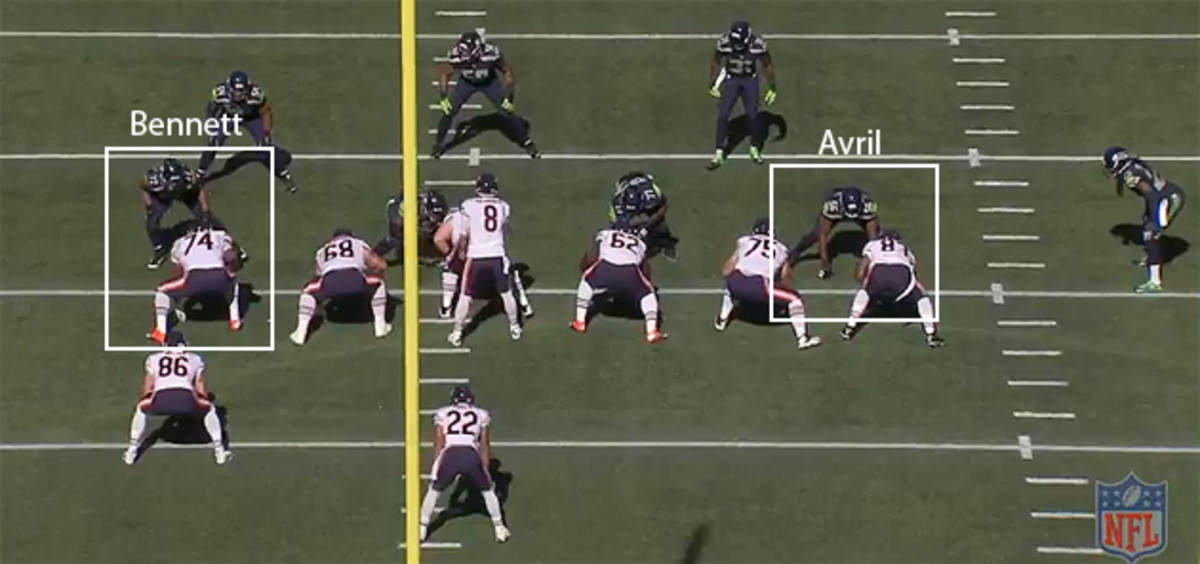
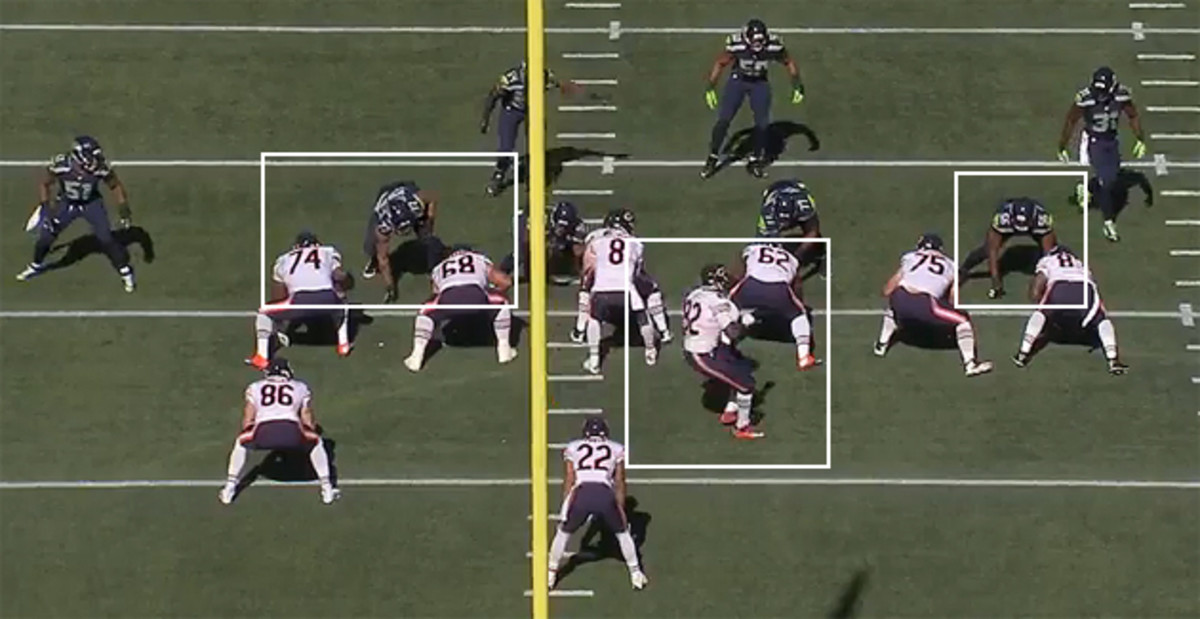
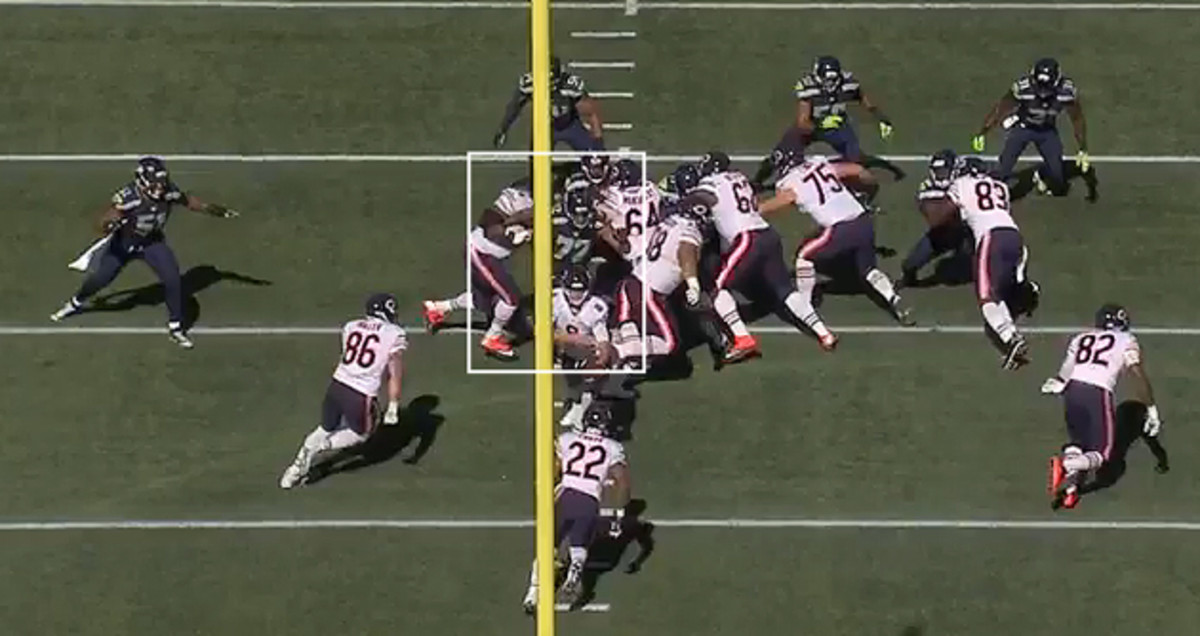
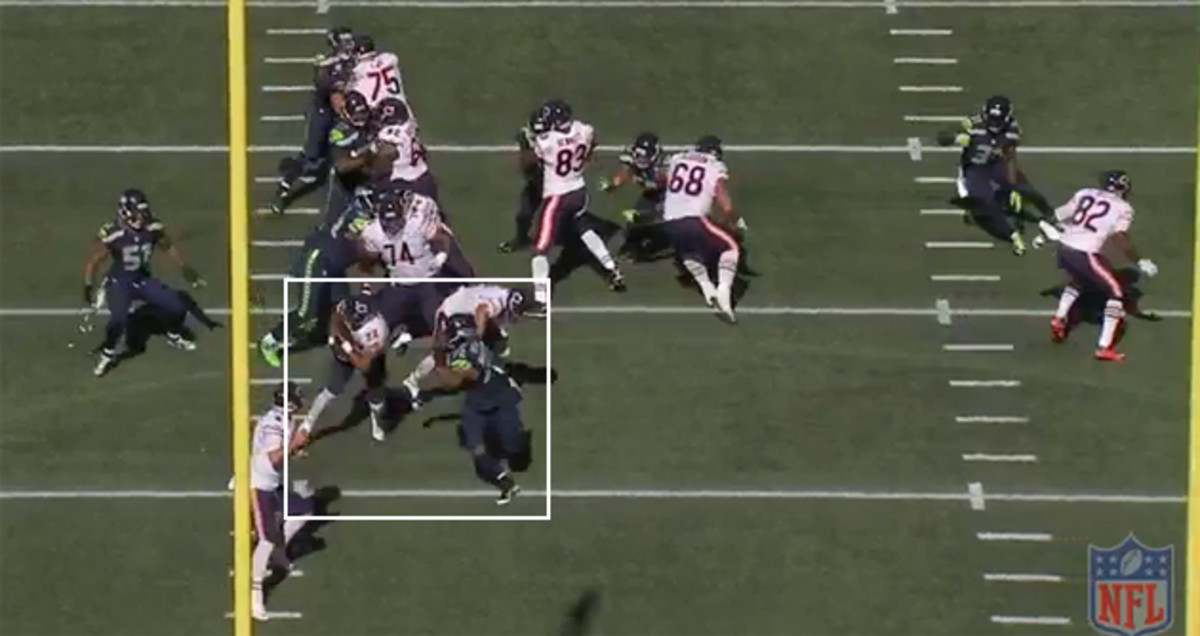
SI: On this play, it’s interesting, because Mike, you’re facing [Bears left tackle Jermon Bushrod], and you’re on his outside shoulder at first. Then you have him straight up, and then you’re inside before shooting through the gap inside Bushrod and in the voided area left by the pulling left guard. Four-yard loss for Matt Forte. What are you seeing there to make you adjust your position?
Bennett: The formation is a formation we saw so many times. Once I saw how the tight end set and the way they went in the motion to the Wishbone, I knew where the ball was going, and I just had to line up and go there. I think a lot of times in the NFL, a lot of guys don’t watch a lot of film. If you think about the guys who watch a lot of film, they’re the guys who make a lot of plays. Luke Kuechly, he obviously watches a lot of film the way he knows where the ball is going before. And I think we do a great job of that. Cliff does a great job of that, knowing when he’s in the 6-technique, where he can take his shots, and I know where I can take my shots as a 3-tech or a head-up 4-tech. We’re in a defense where we’re [sometimes] both head-up [directly over the offensive lineman as a two-gap player, as opposed to off to one side as a one-gap penetrator]. That’s hard. If you look at most guys, they’re on the edge. We’re pretty much head-up the whole game. We are two-gapping defensive ends, pretty much the whole game.
Avril: Yeah, and we’re light to be head-up. Most defensive ends who are head-up are 300 pounds. So, whenever we get those chances, we try and get those keys, we can take the gap and try to make a play.
SI: Mike, the way you split this gap... it’s something I see from you over and over, where you’re so good at reading those openings and crashing through really quickly. How do you develop that skill?
Bennett: It’s just timing. It takes time, and it’s really just film study. You can’t really do that unless you understand what’s going on in the film. If I don’t know what’s going on, I can’t do that. I’d be doing what any regular defensive end would be doing—sitting in the 4-technique, getting blocked. Rather than, ‘Hey, I know where the ball’s going, so why don’t I just go where he’s going?’
Week 16 Snaps: Panthers' first loss of season may be just what they needed
SI: Mike, what the best thing about Cliff's game?
Bennett: The thing I like best about Cliff is his knack to get the ball out. A lot of guys can do sacks, but for some reason, he’s always getting the ball out—finding a way to spin it out. And then, his ability to transform from being a pass rusher to double-digit tackles for loss. It’s his first year of really doing that, and that’s crazy. It’s his eighth year, and he’s still getting better. That’s what I like about his game—he keeps growing, and he has the ability to get around that edge quicker than anybody.
SI: Cliff, what’s half-decent about this guy over here?
Avril: [Laughs] Oh, man—just his versatility. Every gap, everywhere. You can play him wherever. Heck, he’s still trying to become a left end [where Avril naturally plays] as much as possible, and if I’m not in the game, he’s going to left end. But he can do it all. I wish I could play some of the stuff he does on the inside, and how explosive he is. No matter what, he’s always moving forward in the passing game. If they send two, three guys to him, he’s somehow splitting them and making things happen. To be considered small for what he does, to play a 4-technique in our base package, and to be so dominant in the run game, is pretty impressive.
Bennett: I feel that Cliff and I could both be 15-sack guys if we were on the edge consistently. If you think about the two years before we each became here, we were on the verge of being those guys who could get 15 sacks a season. Because we were on the edge, and we understood the game. But that’s the trade you make when you’re playing in a great defense. A couple things we would like to do, we don’t do anymore. That’s part of growing as a person—being able to transform from what you thought was important to what it takes to be part of a team.
Avril: Like he said—put your pride aside, and do what the defense calls for you to do, and do it to the best of your abilities.
